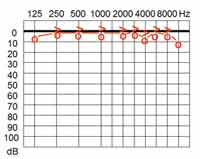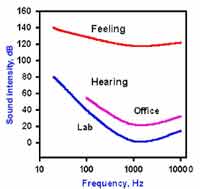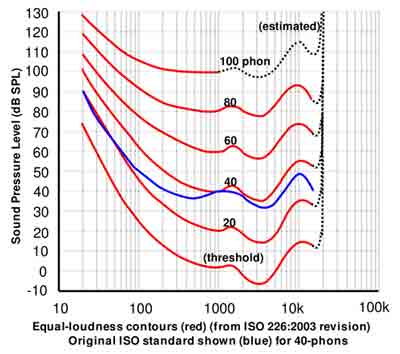What is Audiogram


Standard US shipping included (We ship internationally daily)
Product Description

Audiogram is a graphic record of hearing ability for various sound frequencies that is used to measure hearing loss. The frequency range for most audiogram normally go from 100Hz to 8000Hz, which is most essential for speech comprehension. The "hearing ability" is expressed in dB HL (decibel hearing level), which measures "hearing loss." 0dB HL represents the average hearing threshold for people with normal hearing. The diagram to the right shows a audiogram with normal hearing.

When obtaining an audiogram, the subject is placed in a soundprof room and sound at different frequencies are presented to the subject using an audiometer via a headphones. For each frequency, the sound intensity is going to increase slowly and the subject is asked to indicate when he first hears the sound. Background noise tends to raise the audiability threadhold. The diagram shows the result when the test is taken in the lab (ideal environment) versus one taken in an office. The red line (feeling) is the pain threshold.
Pure tone audiogram tells the pure tone hearing capability of a person in a quiet environment. For tuning a hearing aid for the real world, more tests on word and speech comprehenson within noisy environment is required. The best way to program a hearing aid for a given environment is to place the person in that environment and then do the testing.
Degrees of Hearing Loss
| Normal hearing | -10 to 26dB (adult) -10 to 20dB (children) |
| Mild hearing loss | 27 to 40dB (adult) 20 to 40dB (children) |
| Moderate hearing loss | 41 to 55dB |
| Moderately severe loss | 56 to 70dB |
| Severe hearing loss | 71 to 90dB |
| Profound hearing loss | ≥91dB |
dB HL and dB SPL
dB HL (hearing level) is not the same as dB SPL (sound pressure level), which is an absolute measure of the pressure generated by sound wave. dB HL is determined by conducting hearing tests among a large test group to determine the "equal loudness curve" and the "minimum audibility curve." The data points on these curves are computed by taking the average of the measurements among the test group. In fact, different countries have different standards. For example, the ASA-1951 standard uses a level of 16.5dB SPL at 1 kHz and the later ANSI-1969/ISO-1963 standard uses 6.5dB SPL. The following diagram shows the most commonly used graph developed by D.W. Robinson and R.S. Dadson in 1956. Each line corresponds to a equal loudness contour. Loudness is a human perception and is not the same as sound pressure. Note that the same loudness requires different sound pressure depending on the frequency.
The lowest equal-loudness contour represents the quietest audible tone and is also known as the absolute threshold of hearing.

By definition, 1 phon equals to 1 dBSPL at a frequency of 1 kHz.

Audiogram is a graphic record of hearing ability for various sound frequencies that is used to measure hearing loss. The frequency range for most audiogram normally go from 100Hz to 8000Hz, which is most essential for speech comprehension. The "hearing ability" is expressed in dB HL (decibel hearing level), which measures "hearing loss." 0dB HL represents the average hearing threshold for people with normal hearing. The diagram to the right shows a audiogram with normal hearing.

When obtaining an audiogram, the subject is placed in a soundprof room and sound at different frequencies are presented to the subject using an audiometer via a headphones. For each frequency, the sound intensity is going to increase slowly and the subject is asked to indicate when he first hears the sound. Background noise tends to raise the audiability threadhold. The diagram shows the result when the test is taken in the lab (ideal environment) versus one taken in an office. The red line (feeling) is the pain threshold.
Pure tone audiogram tells the pure tone hearing capability of a person in a quiet environment. For tuning a hearing aid for the real world, more tests on word and speech comprehenson within noisy environment is required. The best way to program a hearing aid for a given environment is to place the person in that environment and then do the testing.
Degrees of Hearing Loss
| Normal hearing | -10 to 26dB (adult) -10 to 20dB (children) |
| Mild hearing loss | 27 to 40dB (adult) 20 to 40dB (children) |
| Moderate hearing loss | 41 to 55dB |
| Moderately severe loss | 56 to 70dB |
| Severe hearing loss | 71 to 90dB |
| Profound hearing loss | ≥91dB |
dB HL and dB SPL
dB HL (hearing level) is not the same as dB SPL (sound pressure level), which is an absolute measure of the pressure generated by sound wave. dB HL is determined by conducting hearing tests among a large test group to determine the "equal loudness curve" and the "minimum audibility curve." The data points on these curves are computed by taking the average of the measurements among the test group. In fact, different countries have different standards. For example, the ASA-1951 standard uses a level of 16.5dB SPL at 1 kHz and the later ANSI-1969/ISO-1963 standard uses 6.5dB SPL. The following diagram shows the most commonly used graph developed by D.W. Robinson and R.S. Dadson in 1956. Each line corresponds to a equal loudness contour. Loudness is a human perception and is not the same as sound pressure. Note that the same loudness requires different sound pressure depending on the frequency.
The lowest equal-loudness contour represents the quietest audible tone and is also known as the absolute threshold of hearing.

By definition, 1 phon equals to 1 dBSPL at a frequency of 1 kHz.
Shipping Information
Shipping Weight: 0.00 Pounds
Availability: In stock! Ready to ship.
Shipping Cost: US Shipping included! Int'l Shipping calculated at checkout
In-stock items are normally shipped within 24-48 hours on business days. For special handling or overnight shipping, please call us at 281-664-1209.
Manufacturer Information
Manufacturer:
Item Code:
Product belongs to these categories...
Hearing Aids

